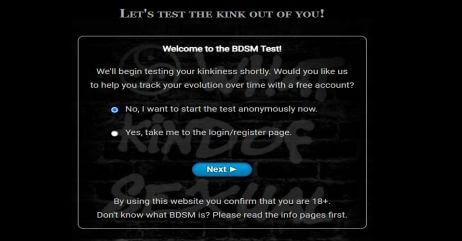Last updated on April 19th, 2025 at 08:41 am
Curious about the BDSM Test and what your results reveal? This guide breaks down how it works, what each role means, and how it helps you understand your kink profile better.
If you’ve ever been curious about your role in the kink or BDSM world, this test is where many begin.
Designed to map out your dominant, submissive, and everything-in-between tendencies, the BDSM Test has become one of the most referenced tools in the kink community.
Unlike the Kink Test, which focuses more on general preferences, the BDSM Test provides a detailed profile of your dominant and submissive traits.
It’s not just a quiz, it’s a profile builder, a conversation starter, and a mirror into your preferences.
You can take the test on one of these reputable BDSM test websites trusted by kink-aware users around the world.
Whether you’re new or experienced, understanding your results can guide how you communicate, play, and explore your dynamic safely.
This post breaks down how the test works, what each label means, and why taking it could deepen your awareness and connection, both with yourself and a partner.
Ready to see where you fit in? Let’s get started.
Recommended: What is a Dominatrix? Roles, Types and How to Become One
Main Points
- A BDSM test is a self-assessment tool that helps identify your BDSM preferences and role, aiding communication, boundary setting, and self-awareness within consensual dynamics.
- Developed in the mid-2000s, the BDSM test quickly became popular, evolving from basic questions to over 100, helping individuals explore and communicate their BDSM interests safely.
- The test helps you discover your desires, improve communication, stay safe, build trust, and find communities that align with your kink interests for deeper connections.
- BDSM roles like Dominant, Submissive, and Switch help define how you interact in power exchange dynamics. Clear communication and respect for limits are key in every relationship.
- While not definitive, the test provides useful insights into your BDSM preferences, offering a starting point for self-exploration and guiding safe, consensual interactions.
Recommended: 55 BDSM Roleplay Ideas To Try Even As A Beginner
Table of Contents
- Main Points
- What is the BDSM Test?
- Types of BDSM Test
- The BDSM Test Origin
- Importance of the BDSM Test
- BDSM Roles
- 20 Types of Questions You Can Find in the BDSM Test and How to Answer Them
- How Reliable and Accurate is the BDSM Test?
- Understanding the BDSM Test Results
- Interpreting the BDSM Test Results
- Embracing and Accepting Your BDSM Identity
- Key Takeaways
- Frequently Asked Questions
- Conclusion
What is the BDSM Test?
A BDSM test is a self-assessment that helps you identify your preferences, boundaries, and role in BDSM dynamics. By answering a series of questions, you get a breakdown of where you stand, whether dominant, submissive, switch, sadist, masochist, or other roles.
This test isn’t about rigid labels; it’s a tool to help you understand your desires and communicate them clearly with your partners.
The questions explore different aspects of BDSM, from control and restraint to pleasure and pain.
Your answers shape a profile that reflects your tendencies, making it easier to navigate consent, limits, and expectations.
Since BDSM is deeply personal, knowing your role can create more fulfilling and safe experiences.
Recommended: What is Femdom aka Female Domination?
Types of BDSM Test
BDSM tests come in many forms, each designed to help you better understand your preferences, roles, and dynamics within the BDSM lifestyle.
These tests can range from simple quizzes to more detailed questionnaires that assess a wide range of interests and kinks.
Below, we’ll explore some of the most popular types of BDSM tests, including the Brat BDSM test and other essential tests you might encounter.
1. Brat BDSM Test
The Brat BDSM test is specifically geared toward identifying individuals who enjoy playing the role of a “Brat” within a BDSM relationship.
Brats are typically submissive individuals who enjoy pushing boundaries, teasing, and testing their Dominants in a playful, defiant manner.
This test helps users identify if they are naturally inclined toward bratty behavior and how it fits into a larger BDSM dynamic.
Those who score highly on this test may find that they enjoy a dynamic where playful resistance is met with firm discipline, leading to a fun and sometimes intense experience. See a dedicated article on the Brat BDSM test.
2. Dominant and Submissive Test
This is one of the most common BDSM tests, assessing whether you lean more toward the Dominant (Dom) or Submissive (Sub) side of the dynamic.
The results help individuals understand how they approach power exchange within a relationship.
While Dominants tend to enjoy control and giving commands, Submissives find satisfaction in surrendering power and pleasing their partner.
Understanding this dynamic is essential for those looking to navigate a healthy power-exchange relationship. See an in-depth article on Dom and Sub tests.
3. Sadism and Masochism Test
The Sadism and Masochism test examines your inclination toward inflicting pain (Sadism) or receiving pain (Masochism) in a consensual context.
While Sadists derive pleasure from causing pain or discomfort (emotionally or physically), Masochists enjoy experiencing it.
This test helps individuals gauge the intensity of their interest in pain play and whether they lean toward giving or receiving pain.
4. Switch Test
The Switch test is for individuals who enjoy both Dominant and submissive roles, depending on the situation or partner.
Switches have the unique ability to move between these roles fluidly, and this test helps clarify how comfortable you are in both Dominant and Submissive positions.
It’s particularly useful for those who want to explore both sides of BDSM play but may be unsure of how they feel about each dynamic.
5. Master/Mistress and Slave Test
This test is designed for those interested in Master/slave dynamics, which tend to be more hierarchical and rigid compared to other BDSM roles.
It assesses the individual’s interest in a strict power exchange, where the Master/Mistress maintains ultimate control over the Slave, who typically has a defined set of responsibilities and limitations.
The results can indicate whether someone enjoys complete submission or taking full responsibility in a relationship.
6. Kink Test
The Kink test is a broad-spectrum BDSM test designed to evaluate your interests in specific kinks and fetishes.
Whether it’s bondage, role-playing, foot worship, or public play, this test highlights where your interests lie and how deeply you are willing to explore these various kinks.
It helps individuals identify which aspects of BDSM they might want to experiment with or focus on in their relationships. See an in-depth guide to the kink test.
7. Bondage and Discipline Test
The Bondage and Discipline test delves into the specific aspects of Bondage (physical restraint) and Discipline (the use of rules and punishment).
For those who are interested in bondage, the test can reveal whether they prefer restraint methods like ropes, cuffs, or chains.
The discipline side looks at your desire for structure, rules, and consequences, which often play a significant role in the power-exchange relationship dynamic.
8. Total Power Exchange (TPE) Test
The TPE test is designed for individuals interested in a Total Power Exchange dynamic, where one partner holds complete control over all aspects of the relationship.
This test helps gauge the depth of your interest in surrendering total control and embracing a relationship that may extend beyond BDSM play, influencing everyday activities, decisions, and even lifestyle choices.
9. Voyeurism and Exhibitionism Test
The Voyeurism and Exhibitionism test helps identify individuals interested in observing or being observed in sexual or intimate situations.
Voyeurs enjoy watching others, while exhibitionists take pleasure in being watched.
This test can help clarify whether your interest lies in exploring the thrill of being observed or watching others in BDSM play.
10. TikTok BDSM Test
The TikTok BDSM Test is a viral version of the traditional BDSM role quiz, popularized through short-form content on TikTok.
While not as in-depth as some of the more established tests, it offers a quick and engaging way to introduce people to their potential Dominant, Submissive, or Switch roles.
It often uses fun visuals, sliders, and simplified role descriptions, making it a favorite among younger or curious audiences exploring kink for the first time.
Its viral nature makes it a cultural gateway into the larger BDSM conversation. See an in-depth guide to the TikTok BDSM test and how to take it.
The BDSM Test Origin
The BDSM test was developed in the mid-2000s by enthusiasts to aid self-discovery within the BDSM community.
Introduced in 2008 by an individual known as “Ged” on bdsmtest.org, it quickly gained popularity.
The test, which initially featured a basic set of questions, has evolved to include over 100 questions, exploring various BDSM aspects such as dominance, submission, and sadomasochism.
It has been widely used for personal exploration and to communicate preferences and has also been incorporated into academic research to better understand BDSM interests.
Its development reflects the growing need for tools that help individuals in the BDSM community connect and explore their sexuality safely and consensually.
Importance of the BDSM Test

The BDSM test has many benefits that include the following:
- Discover What Feels Right: The BDSM test helps you understand your desires, limits, and role, whether Dominant, Submissive, Switch, or drawn to specific kinks.
- Talk About What You Want: Your results give you the words to express boundaries, kinks, and interests, making communication with partners clearer and more comfortable.
- Stay Safe While Exploring: Knowing your limits helps you engage in BDSM safely, avoiding risky situations and ensuring all experiences are consensual and enjoyable.
- Build Deeper Connections: Sharing your test results strengthens relationships by aligning expectations, improving trust, and creating fulfilling experiences based on mutual interests.
- Find the Right Communities: Your results connect you with forums, events, and resources, helping you learn, grow, and meet like-minded people who share your kinks.
Related: The BDSM Brat: Beyond The Playful BDSM Persona
BDSM Roles

BDSM revolves around power exchange, where partners take on different roles based on their desires and limits.
The three main roles:
- Dominant
- Submissive, and
- Switch
…define how you engage in these dynamics. Knowing where you stand helps you communicate better, set clear boundaries, and build trust with partners.
Dominant: Taking Control with Responsibility
As a Dominant, you take charge in the dynamic, setting rules and guiding the experience.
Your role isn’t just about control, it’s about responsibility. You ensure that limits are respected, consent is always present, and your partner’s well-being comes first.
A good Dominant listens, communicates openly, and prioritizes trust and safety.
Related: What is a Fetish?
Submissive: Surrendering with Trust
Being Submissive means willingly giving up control within agreed boundaries.
You find pleasure in obedience, restraint, or serving a Dominant, but your limits matter.
Clear communication is key, you have the right to express your needs, set boundaries, and withdraw consent at any time.
A healthy submissive-dominant relationship thrives on mutual respect, not blind obedience.
Switch: Balancing Both Worlds
If you enjoy both Dominant and Submissive roles, you’re a Switch. Some prefer to switch based on mood, partner, or scenario, while others naturally shift between roles.
This flexibility allows for a broader BDSM experience, offering insight into both perspectives.
Suggested: Breast Bondage Basics
20 Types of Questions You Can Find in the BDSM Test and How to Answer Them

The test includes various types of questions to explore different aspects of your BDSM interests and dynamics:
1. Are you comfortable with power exchange dynamics?
How to Answer: Reflect on your comfort level with taking on dominant or submissive roles. Answer based on your experiences and desires.
2. Do you enjoy giving or receiving physical pain as part of sexual activities?
How to Answer: Consider your feelings towards impact play like spanking or whipping. Answer based on whether these activities align with your interests and boundaries.
3. How important is clear communication and consent in your BDSM activities?
How to Answer: Emphasize the importance of communication and consent in safe BDSM practices. Your answer should reflect a commitment to ensuring both partners are comfortable and fully informed.
Recommended: Differentiating Kink Test from BDSM Test
4. Would you enjoy being restrained or restraining your partner during play?
How to Answer: Think about your preferences for bondage or restraint scenarios. Answer honestly about whether you find the idea appealing or if you’re curious to explore it.
5. Are you interested in exploring psychological aspects of BDSM, such as humiliation or degradation?
How to Answer: Assess your interest in the mental and emotional aspects of BDSM. Answer based on your comfort with activities involving psychological play, keeping your limits in mind.
Related: The Sissy Kink: History, Evolution, Fetishization, and Feminization
6. How do you feel about switching roles between dominant and submissive?
How to Answer: Reflect on whether you enjoy or are open to experiencing both sides of power dynamics. Your answer should convey your flexibility or preference for one role.
7. Is the concept of ‘Total Power Exchange’ (TPE) appealing to you?
How to Answer: Consider whether the idea of one partner having complete control excites or interests you. Answer according to your comfort with such a level of commitment.
8. Do you prioritize aftercare following a BDSM scene?
How to Answer: Highlight the importance of aftercare in maintaining the emotional and physical well-being of participants. Your answer should reflect your understanding of the need for care after intense scenes.
9. Are you open to experimenting with different types of BDSM activities?
How to Answer: Evaluate your curiosity and willingness to try new things within BDSM. Answer based on your openness to exploring various activities, from light to intense scenarios.
Related: What Is Petplay? An Introductory Guide
10. Do you have specific hard limits that are non-negotiable?
How to Answer: Be clear about your boundaries and any activities you are not comfortable with. This is crucial for defining your limits, so answer honestly.
11. Do you prefer a more structured or flexible BDSM dynamic?
How to Answer: Think about whether you thrive in a highly structured environment with clear rules or if you prefer a more fluid dynamic. Answer based on your personality and relationship style.
12. How do you feel about incorporating sensory deprivation into play?
How to Answer: Consider your comfort with activities like blindfolding or gagging that limit senses. Answer according to whether these activities excite you or fall outside your comfort zone.
13. Are you interested in role-playing scenarios within BDSM?
How to Answer: Reflect on whether acting out different roles appeals to you. Your answer should indicate your level of interest in role-play as part of your BDSM activities.
14. How do you approach setting boundaries in BDSM relationships?
How to Answer: Consider how you communicate your limits and expectations. Answer based on your approach to open dialogue and mutual respect in setting boundaries.
15. Do you enjoy or are you curious about medical play in BDSM?
How to Answer: Think about whether activities involving medical instruments or themes intrigue you. Answer based on your comfort level with this type of play.
16. How do you feel about public displays of BDSM or kink?
How to Answer: Reflect on your comfort with showing your BDSM lifestyle in public or semi-public settings. Answer based on whether you prefer to keep it private or are open to public displays.
17. Are you interested in chastity play, including the use of devices like chastity cages?
How to Answer: Consider whether the idea of control over sexual activity, including chastity devices, appeals to you. Answer honestly based on your level of interest or curiosity.
18. How do you feel about incorporating fear or adrenaline into BDSM play?
How to Answer: Consider whether activities that induce fear or adrenaline, like edge play, are appealing. Answer based on your willingness to explore these intense experiences.
19. Are you comfortable with long-term or 24/7 BDSM dynamics?
How to Answer: Reflect on whether you’re interested in maintaining a BDSM dynamic that extends beyond play sessions into daily life. Answer based on your comfort with or interest in this level of commitment.
20. Do you enjoy or are you curious about financial domination (findom) in BDSM?
How to Answer: Consider whether the concept of financial control, where one partner manages or takes control of the other’s finances, intrigues you. Answer based on your interest or comfort with this aspect of BDSM.
How Reliable and Accurate is the BDSM Test?

The reliability and accuracy of the BDSM Test can vary depending on many factors.
While the test can offer useful insights into an intending participant’s BDSM interests and preferences, it should be considered a tool rather than an absolute assessment.
The accuracy of the results depends on the honesty and thoughtfulness of the responses, as well as the test’s ability to capture the grey areas of individual experiences.
Also, since BDSM is a highly personal and evolving aspect of sexuality, the test’s results may not fully reflect a person’s preferences or growth over time.
It is best used as a starting point for self-exploration and communication rather than a conclusive measure of one’s BDSM identity.

Related: What are Safe Words in BDSM?
Understanding the BDSM Test Results

Here are a few tips to help you navigate your result:
- Look Up the Terms: BDSM includes different kinks, roles, and dynamics. Researching the meanings helps you understand how they relate to your desires.
- Break Down the Categories: Your results are divided into sections like Dominance, Submission, and Sadomasochism, giving insight into different aspects of your interests.
- Analyze Your Scores: Higher scores mean stronger interest in certain areas, while lower ones suggest they may not align with your current preferences.
- Think About Your Experiences: Compare your results with past fantasies or encounters. Keeping a journal can help track thoughts and shifts in your understanding.
- Assess Your Comfort Level: Do your results match how you feel? Recognizing what excites or unsettles you helps define boundaries and personal limits.
- Talk with Your Partner: If you’re in a relationship, sharing results encourages honest conversations, helping both of you understand each other’s interests better.
- Try New Things Safely: Use your results as a guide to learn, experiment, and explore BDSM in a way that aligns with your interests.
- Find Reliable Resources: Join forums, read books, or connect with experienced practitioners to gain deeper knowledge and ask questions about BDSM dynamics.
Interpreting the BDSM Test Results

Here are the results for eight different categories, each representing a specific aspect of BDSM behavior:
Dominant (D)
This measures your desire to take control in BDSM. A high score means you enjoy leading, setting rules, and having authority.
Submissive (S)
This reflects your comfort in following a dominant partner’s lead. A strong score suggests you enjoy surrendering control and following instructions.
Switch (Swt)
This category shows your ability to shift between dominance and submission. A high score means you enjoy both roles equally.
Masochist (M)
This measures your enjoyment of receiving pain or intense sensations. A strong score suggests pleasure from spanking, bondage, or humiliation.
Sadist (Sd)
This indicates your interest in giving pain for pleasure. A high score suggests enjoyment of spanking, roleplay, or consensual dominance.
Vanilla (Va)
This category reflects your preference for non-kinky intimacy. A strong score suggests comfort with traditional sexual dynamics over BDSM elements.
Experimental (X)
This measures your curiosity about new experiences. A high score suggests you’re open to exploring different kinks and unconventional activities.
Non-Monogamous (NM)
This shows your openness to multiple romantic or sexual relationships. A high score suggests interest in polyamory, open relationships, or swinging.
Understanding Your BDSM Test Scores
81-100%: Very high interest and strong desire for engagement.
1-20%: No real interest in that category.
21-40%: Mild curiosity but not a strong preference.
41-60%: Moderate interest, possibly open to experimenting.
61-80%: Strong attraction to activities in that category.
Embracing and Accepting Your BDSM Identity

Understanding and accepting your BDSM identity involves acknowledging and embracing desires, interests, and needs related to this aspect of sexuality.
It is important to recognize that BDSM is a consensual practice involving the exploration of power dynamics, control, and various physical and psychological sensations.
Contrary to misconceptions, it is not inherently abusive or non-consensual.
Self-discovery, self-awareness, and education play key roles in accepting this identity.
This includes identifying desires, fantasies, and boundaries, as well as learning about negotiation, consent, safety practices, and communication skills.
Engaging in discussions, research, and connecting with like-minded individuals can be helpful.
Coming out to trusted individuals or joining BDSM communities can provide support and a sense of belonging.
Respecting oneself and others is crucial, emphasizing the importance of consent, negotiation, and open communication in BDSM relationships.
Power dynamics and kinks can exist in a healthy, safe, and respectful manner.
See more varieties of websites to take the BDSM Test.
Key Takeaways
1. The test results are not definitive or absolute. They are simply a reflection of your responses to the questions asked on the test.
2. The test results can help you gain insight and understanding into your own desires, preferences, and fantasies within the BDSM realm.
3. Your test results may include different aspects of BDSM, such as dominant or submissive tendencies, bondage preferences, sadism or masochism inclinations, and more.
4. It’s important to remember that kink test results do not determine your worth as a person or your level of experience in BDSM. They are simply a tool for self-discovery and exploration.
5. The result can serve as a starting point for further discussions with your partner(s) about your shared interests and boundaries.
6. It’s crucial to take the time to reflect on your results and understand what they mean to you. It’s okay to feel uncertain or curious about certain aspects of your results.
7. They should never be used to judge or shame yourself or others. Everyone’s preferences and desires are valid as long as they are consensual, safe, and respectful.
8. Your test results can change over time as you explore and learn more about BDSM. It’s a journey of self-discovery that evolves with experience and understanding.
9. The results are personal and private. It’s your choice whether or not to share them with others, and you should always respect the confidentiality and boundaries of others when discussing BDSM.
Frequently Asked Questions
How does the BDSM test function?
It operates by presenting a series of inquiries regarding your sexual preferences, fantasies, and experiences. Based on your responses, the test calculates your BDSM personality type and generates a comprehensive report.
Can I take the BDSM test anonymously?
Certainly, you can take the test anonymously. There is no requirement to disclose your real name or any identifying information while taking the test.
Is the BDSM test accurate?
The test draws upon extensive research and experience within the BDSM community. While it strives to be as accurate as possible, it cannot provide definitive answers regarding your sexuality or preferences.
Is it safe to take the BDSM test?
Certainly, taking the test is safe. Your answers are treated as confidential and are not shared with any third parties.
What do the different BDSM personality types Indicate?
The BDSM personality types indicate your dominance and submission levels, as well as your interests and preferences within the BDSM preference spectrum, which include dominant, submissive, switch, vanilla, and primal.
Can I utilize the results of the BDSM test to explore BDSM?
Certainly, the BDSM test results can be beneficial in exploring BDSM. Your report will furnish you with information about your BDSM personality type, along with recommendations for further exploration and available resources.
Conclusion
The BDSM Test is a powerful tool for exploring and understanding your kink profile.
By identifying dominant, submissive, or switch tendencies, it enhances communication with partners and guides safe, consensual play.
While results are not absolute, they offer valuable insight into personal preferences, helping you navigate boundaries and explore your desires with confidence.
Whether you’re new to BDSM or an experienced participant, the test aids in deeper self-awareness and connection with like-minded individuals.
It encourages honest discussions, ensuring that everyone involved in BDSM dynamics can engage in fulfilling, respectful experiences.
Embrace the test as a tool for self-discovery, and always prioritize consent and communication in every encounter.
References:

